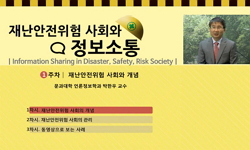Conceptual frameworks of inter-relationships among disaster risk, natural hazards and ecosystem services are provided in consideration with disaster mitigation and social recovery after hazards. Recent trends of disaster reduction measures include eco...
http://chineseinput.net/에서 pinyin(병음)방식으로 중국어를 변환할 수 있습니다.
변환된 중국어를 복사하여 사용하시면 됩니다.
- 中文 을 입력하시려면 zhongwen을 입력하시고 space를누르시면됩니다.
- 北京 을 입력하시려면 beijing을 입력하시고 space를 누르시면 됩니다.
Future Trends of Disaster Reduction Measures Based on Environmental Disaster Mitigation Concept
한글로보기https://www.riss.kr/link?id=A105611006
- 저자
- 발행기관
- 학술지명
- 권호사항
-
발행연도
2016
-
작성언어
English
- 주제어
-
자료형태
학술저널
-
수록면
5-10(6쪽)
- 제공처
-
0
상세조회 -
0
다운로드
부가정보
다국어 초록 (Multilingual Abstract)
Conceptual frameworks of inter-relationships among disaster risk, natural hazards and ecosystem services are provided in consideration with disaster mitigation and social recovery after hazards. Recent trends of disaster reduction measures include ecosystem services under the name of Eco-DRR. Most of them take into account of roles for reducing disaster risk such as a buffering by decreasing physical exposure to hazards but not always for increasing the ecosystem services. Natural hazards have important roles in creation and/or renewal of ecosystem structure, being essential for sustainability of ecosystem services. Therefore, in order to ensure social life styles depending on ecosystem services, future disaster reduction measures should include environmental disaster mitigation allowing the changes in ecosystem structure as a result of natural hazards. Further studies for prediction of ecosystem changes after hazards are required as well as those under climate changes for better society in future. In this sense, a catastrophic event of hazard might be a good chance to change social systems into those with more sustainable resource use and life styles.
목차 (Table of Contents)
- Abstract
- Introduction
- Ecosystem changes by hazards
- Eco-DRR measures now
- Future trends of hazard management
- Abstract
- Introduction
- Ecosystem changes by hazards
- Eco-DRR measures now
- Future trends of hazard management
- ACKNOWLEDGMENT
- REFERENCES
동일학술지(권/호) 다른 논문
-
Influence of Mental Health Nurses' Moral Distress and Job Satisfaction on Turnover Intention
- 위기관리 이론과 실천
- J. W. Hwang
- 2016
-
Post-traumatic Stress Risk Factor in Fire Fighters
- 위기관리 이론과 실천
- Yoonjung Kim
- 2016
-
A Study On Mental Health of Nurses - Focused on Anger and Job Stress -
- 위기관리 이론과 실천
- Mi-Gyeong Yang
- 2016
-
Socio-ecological Resilience of Hebei Spirit Oil Spill
- 위기관리 이론과 실천
- Gi-Geun Yang
- 2016




 eArticle
eArticle





